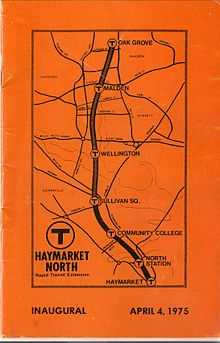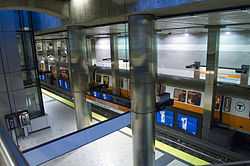Haymarket North Extension
The Haymarket North Extension is a section of the Massachusetts Bay Transportation Authority's rapid transit Orange Line which currently constitutes the northern section of the line. It runs from North Station (MBTA station) through an underground crossing of the Charles River, then along the Haverhill Line right-of-way to Oak Grove station in Malden, Massachusetts. Built to replace the Charlestown Elevated and originally intended to be extended as far as Reading, it opened in stages between 1975 and 1977.
History
Need
Unlike the Washington Street Elevated which was built as the same time with a similar design, the Charlestown El was located very near Boston Harbor and the Mystic River tidal estuary, and was thus continually exposed to accelerated corrosion caused by salt air. The elevated was also unpopular with many local residents, as it was noisy and blocked out sunlight to Main Street. In the 1960s, it was determined that a replacement elevated would not be wise to build, and that a full-length replacement tunnel would be too expensive. Additionally, original plans to extend the El to Reading would never have been possible to realize, as the line would have run required an unpopular and thus politically infeasible elevated routing down Main Street through Malden, Melrose, Wakefield, and Reading.Instead, the Haymarket North Extension project was built with tunnels and existing rights of way.
Route and construction

The extension replaced the Canal Street Incline, where the old El came to the surface north of Haymarket, with a tunnel under Canal Street to a new underground station at North Station which replaced the elevated station. The tunnel continues north under the Charles River to Charlestown, with an aboveground station at Community College that roughly replaced the former City Square and Thompson Square stations. It runs on the surface under the Interstate 93 viaduct - constructed at the same time - and crosses the Haverhill Line and Newburyport/Rockport Line on a flyover, touching down at Sullivan Square (which replaced a nearby El station of the same name). The Charlestown El closed on April 4, 1975, and the new segment from Haymarket to Sullivan opened on April 7.[1]
The next section, from Sullivan over the new Edward Dana Bridge to Wellington, opened on September 6, 1975.[1] The Wellington Shops, which replaced the Sullivan Square Shops and later the Forest Hills Shops, were opened with this extension. From Sullivan northwards, the Extension runs entirely along the Haverhill Line right of way, which substantially lowered land acquisition difficulties during construction. An additional segment to the elevated Malden Center, which includes a platform for the Haverhill Line, opened on December 27, 1975.[1] After debate about how far the extension would run, it was decided that it would terminate at the north edge of development in Malden, rather than continue through a narrow pass between the Middlesex Fells and the Pine Banks and into the less dense suburbs of Melrose and Wakefield. The sixth and terminal station of the Extension, Oak Grove, opened on March 20, 1977.[1]
Reading
The extension was originally to continue further north to Reading and replace commuter rail service entirely between Boston and Reading. However, that extension was voted down by residents of Reading. Under that plan, without commuter tracks between Boston and Reading, Haverhill trains would have solely used the Lowell Line and Wildcat Branch - a routing used today only for a handful of rush hour trains and Amtrak's Downeaster service. A third express track was built between North Station and Wellington station which would have been extended north to provide express service to Reading. Due to the extension being cut back to Oak Grove, no regular service uses this third track; it is occasionally used for other purposes like testing equipment.
Architecture
Like the South Shore Line (Red Line Braintree Branch) stations built in the same period, the original Haymarket North Extension stations were constructed in a Brutalist style, with angular concrete forms. Community College and Sullivan Square, enclosed under the I-93 viaduct, are primarily rectilinear forms; the later stations incorporate angled forms for staircases and elevators as well.
Assembly station
In the early 2000s, Somerville began planning the Assembly Square development, built on the abandoned site of the former Somerville Assembly automobile plant. A key piece of the development was an infill station at the site between Sullivan Square and Wellington to reduce the number of car trips generated. After two years of construction, Assembly, which opened on September 2, 2014. It was the first fully new station on the MBTA subway system since 1987, and the first infill station since Science Park in 1955.[1] Assembly station has an island platform between the two main tracks; during construction, outbound trains were diverted onto the normally unused third track, and inbound trains onto the outbound track. The station has a boxy class form, with a similar shape to the original Extension stations but different style.
Station listing
| Station | Opening date[1] | Notes | |
|---|---|---|---|
| Oak Grove | March 20, 1977 | ||
| Malden Center | December 27, 1975 | Transfer to Haverhill Line | |
| Wellington | September 6, 1975 | ||
| Assembly | September 2, 2014 | Infill station (not part of original extension) | |
 |
Sullivan Square | April 7, 1975 | Separate from elevated station it replaced |
| Community College | April 7, 1975 | ||
 |
North Station | April 7, 1975 | Replaced elevated station; rebuilt in 2005 as a "superstation" with direct transfers to the Green Line |
References
| |||||||||
| ||||||||||||||||||||||||||||||||||||||||||||||||||||||||||